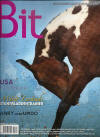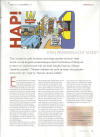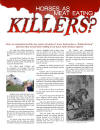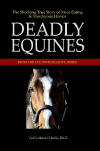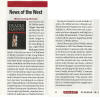Deadly Equines - The Shocking True Story of Meat-Eating and Murderous Horses
June 2012: The “Deadly Equines” project continues to receive unsolicited evidence from around the world. It has been discovered that two more Historical Long Riders wrote about Tibet’s meat-eating horse culture.
English Long Rider, Henry Savage Landor, made an astonishing revelation. After his trip to Tibet in 1897, Savage Landor wrote that he had to pay particular attention to the large wild equines known as kiangs.
"The natives regarded their near proximity as extremely dangerous, for their apparent tameness is often deceptive, enabling them to draw quite close to the unwary traveller, and then with a sudden dash seize him by the stomach, inflicting a horrible wound with their powerful jaws."
In the winter of 1949 American Long Rider Leonard Clark witnessed meat-eating horses in Tibet.
“Tujeh ordered three of the most tired horses fed with dried meat and tsamba, which seemed to revive them. Tibetans and Mongols feed fatty meat to their horses during such emergencies of cold, or even when on a fast raid or hard journey. Mongol legend says they were able to cover great distances at high speed by the use of this feeding; hence the superiority of their cavalry over all others. The Ngolok tribe chop dried kyang meat and feed it to their horses.”
More recently, American Long Rider Doug Preston found additional evidence demonstrating that equines are omnivores. Doug interviewed an elderly Tibetan who had sought political refuge in the United States after the Chinese invaded Tibet. He too had a story about Tibet’s meat-eating horses.
“I was having dinner with an old Tibetan refugee in Santa Fe. He fled China at the same time as the Dalai Lama in the early 1950s, in an incredible journey across the Himalayas by horseback that took two years. They were ambushed and shot at by Chinese troops, many were killed over the course of the journey. I asked him how the horses survived in the high Himalayas for two years, in the wintertime, with no forage and no grain. He said they ate yak meat, which, he says, was a traditional part of the Tibetan equine diet. And they thrived, the meat carrying them through one of the most challenging equine journeys in history.”
15th April 2012 - Hospital patient in Kent, England was kicked and mauled to death by stallion after she went for a walk.
31st March 2012 - "Three-year-old boy in pony attack terror". The boy needed hospital treatment after being bitten by a pony and hurled five feet through the air. This took place in Sunderland, England.
November 2011 - Children attacked by horse – A horse has repeatedly attacked children and adults in Suffolk, England. The local newspaper published a front page story detailing how the horse, which is kept in a field adjacent to a narrow public footpath, had grabbed children from their parents, picked them up, shaken them violently, then flung them to the ground. The paper published a photo of a four-year-old victim who was bitten in the chest. One father was also attacked by the horse.
| Click on image at right to read a review of Deadly Equines published in the Dutch magazine, Bit. Note: the cover image (left) was taken by Paula da Silva, one of the premier equestrian photographers working in Europe today. Paula is a Friend of The Long Riders' Guild. |
| Click on image to read a review of Deadly Equines in America's excellent equestrian magazine, Horse Connection. | |
|
|
The webmaster of the respected website, About.com, contacted the Guild and requested a review copy of Deadly Equines. After reading it, she wrote about feeding meat to your horse. "A horse may be trained to eat meat or it may be driven to it by need. This doesn’t mean that a regular diet of meat in the long term is a good thing. Your horse may like an occasional bite of your hamburger or salmon sandwich and can eat it without harm." |
Here is a review of Deadly Equines published (in English) on Amazon.de - the German-language online bookshop.
An excellent article has been published in Équi-Libre, Canada's leading equestrian magazine published by the association of Québec à Cheval in Canada. Pearl Duval, the author, admits that when she started reading Deadly Equines she had grave doubts but, after consulting scientists in Canada, now readily accepts that horses can indeed eat meat and some may be aggressive. Click on images below to read the article (in French). To read an English translation, click here.
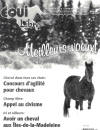 |
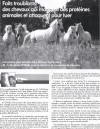 |
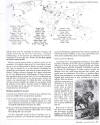 |
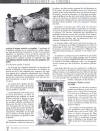 |
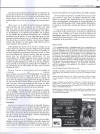 |
BEST-SELLING BOOK ABOUT MEAT-EATING HORSES
New York Times best-selling author, Maggie Stiefvater's newest book, " The Scorpio Races," features meat-eating horses. ".....the meat-eating mounts of this inventive, tightly woven tale have the ability to lull their human riders into a stupor whereby the fairy horses can then carry them back to the ocean to be devoured."
Here is a link to another radio show about Deadly Equines and Long Riders on with Tim Binnall (BoA). "Traveling down a truly unique and fringe road, BoA:Audio welcomes equestrian researcher and Long Rider CuChullaine O'Reilly for a discussion on his groundbreaking book Deadly Equines: The Shocking True Story of Meat-Eating and Murderous Horses. Over the course of this two hour adventure, we'll discuss CuChullaine's powerful case for meat-eating horses, including historical accounts from ancient and contemporary times, the collective 'equestrian amnesia' that has befallen the 'civilized world,' and the reaction to his research from the equestrian community. Plus, we'll discuss murderous horses, a separate, but equally bizarre anomaly that CuChullaine has uncovered. Along the way, we'll also spend considerable time discussing the mind-bending world of long riding. Fascinating, enlightening, and awe-inspiring, this conversation is a proverbial 'long ride' of esoteric insights on both equines and humans with the remarkable CuChullaine O'Reilly."
And here's an excellent review of the book. "This fascinating book focuses on historical and contemporary accounts of all sorts. The effect is surprising: it's easy to dismiss a handful of stories as aberrant behavior or tall tales. But the body of evidence - spanning cultures around the world, and throughout history - is truly convincing.... The biggest surprise of Deadly Equines may be that it is so readable, and that its evidence is presented so calmly. O'Reilly wisely avoids sensationalizing his topic. Surely it is sensational enough not to require any more gilding on that particular lily; still, though, I am positive that many other authors would have gone for the gusto here. O'Reilly's authorial tone remains restrained and reasonable throughout." Read the full review at the Animal Book ClubAnother thoughtful review on History on Horseback. "The heart of the book is a gripping and incredibly well-researched section based on the real-life experience of travellers with horses, from Mongolia to the Polar regions and elsewhere. It’s packed with detail and full of solid facts relating to the subject, with links to videos and web pages of relevance. I learned masses from this section, about the “blood tsampa” fed to horses in Tibet and the “Maujee rations” fed to Shackleton’s horses and much, much more."
Here is an historical example from Australia: 29th January 1941 – The Barrier Miner, Broken Hill, Australia
SYDNEY. Wednesday. – A grazier at Nevertire has been concerned by the death of more than 100 of his sheep and injury to others of the flock. The dead sheep had their jaws, throats, and ears chewed and the injured had their ears torn off. The culprit was found to be a horse. It would rush at a sheep and grab it by the head. Some weeks ago the, horse was put in the paddock by an unknown person.
Another example, this one from Tasmania: 15th August 1941 – The Examiner, Launceston, Tasmania
HORSE EATS RABBITS - Case at Winnaleah
In the North-East there is a young horse which eats rabbits, robs a dog of a carcass or pulls rabbits out of traps, chews the head off and sucks the blood. This carnivorous horse is owned by a well-known farmer at Winnaleah. He writes as follows to "Pegasus," veterinary contributor to "The Examiner": "I have on my farm at Winnaleah a young horse which on his breeding might someday be valuable. He is rising two years and has taken to eating rabbits. This, you might think, is unbelievable, and I did not believe it when a man who was trapping rabbits told me about it. In fact, he was rather annoyed because I laughed at the idea, but just at that moment the dog I had with me pulled a skinned rabbit out of a stump hole. The horse saw the dog with it, galloped after the dog until he dropped the carcass, and the horse picked up the rabbit and ate it. Since then he has eaten quite a few with the skins on. In fact, he will follow a line of traps when he hears the rabbits squealing. In some cases he will chew only the head and neck off and suck the blood out of them. "The horse is in good condition and he does not do it because he is hungry. Do you think I ought to shoot him, or what would you suggest? At present I have got him shut in a paddock where no trapping is being done."
Here is a review of Deadly Equines by Alexander Hay. "Deadly Equines - The Shocking True Story of Meat-Eating and Murderous Horses sounds absurd - a joke at the reader's expense - until you realise that what is being challenged is our own limited understanding of these creatures. In part this is due to the evidence the book provides. The historical record is full of shockingly vicious horses that killed and maimed in a way that would probably bar them from most pony clubs. There are incidences of horses quite happily eating everything from rabbit to whale to tiger, with human and hamster thrown in for good measure."
“The book's absolutely fascinating. I must admit what it mostly did for me was make me think, surely the ultimate objective of any author. Brilliant.” Jonathan Hopkins – an expert on the British cavalry who fought against Napoleon and author of Walls of Jericho – A Cavalry Tale .
“A stunning book, and I mean
stunning. It feels like I have been hit over the head.”
Simon Mulholland – Equestrian inventor and social
activist.
| News of meat-eating horses is published in the current
edition of Wild West magazine in the USA! Click on image to the right
to enlarge it. The dictionary defines an omnivore as "an animal or person that eats food of both plant and animal origin." An animal that eats food of both plant and animal origin?
Evidence indicating that horses are capable of omnivorous dietary action continues to grow.
|
When the book was published the known list of meat which horses had known to have consumed included: Antelope, Beef, Birds, Chicken, Fish, Goat, Hamster, Horse, Human, Moose, Offal, Onager, Polar Bear, Rabbits, Seal, Sheep, Whale, Yak.
Since then the list has grown.
In the first 72 hours after the book was released, the Guild received news about horses in Arabia who consume raw camel meat, American horses who devour live crayfish, the BBC filmed horses eating fish on the beach of an English island, and Mariwari horses in India enjoy consuming goat's head soup.
In the last few days the Long Riders' Guild has also received messages from horse owners who wrote to state that their animals consumed barbecue goat (bones and all), scavenged crabs off the beach, bit baby lambs and then consumed the blood, not to mention eagerly devouring enough different types of human cuisine to fill a cookbook.
And we have just been informed of a horseman who, a few hours after completing his reading of the book, offered his horse a pound of raw ground beef mixed with his grain. The horse eagerly ate it.
Thus, despite the commonly held belief that horses are strict herbivores, new evidence suggests that the equine digestion system is more robust than suspected and that horses are capable of enacting omnivorous behaviour with no ill effects.
Nor has additional evidence of extreme equine aggression been lacking.
It is a sad irony that in the few weeks since the book was released we have received evidence of five similar equine attacks to the one in Australia which prompted the book to be published. One of the survivors was seven at the time the horse seized her by the throat and nearly killed her. A woman in Holland died when the horse tore out her throat. Similar attacks occurred in Egypt and India.
The latest evidence of
extreme equine aggression occurred in Oklahoma, where a
horse deliberately slew a four-year-old child. According to news reports, the
child was playing in his fenced front yard, when the horse made the decision to
jump out of its adjacent pasture onto the family lawn. Having missed grabbing
the child by the throat, the horse ripped off the child's right arm, then
savaged him to death in front of the horrified parents.
According to the news report, there had been no warning or provocation.
Moreover, the horse was owned by the same family, so they had no reason to
suspect it of extreme aggression. Nor was there any previous hint of disease.
Another startling episode involves the first horse known to have eaten meat and attacked humans. In 1958 a gelding named Freight Train was observed following a mother duck and her ducklings. He would pick up a duckling, chew and swallow it, then move on to the next one. The horse eventually ate all four of the baby birds.
The fact that the ducklings were small is not the issue. The fact remains that the horse made the decision to pursue the ducklings (i.e. hunt them), and as a Swedish horseman said, became "a predator by choice."
This same horse was the cause of so many attacks against humans, that his owners fitted him with a wire muzzle.
Nor has additional historical evidence been lacking.
During the Napoleonic campaign in Spain, Captain Thomas Brotherton reported on his meat-eating Arab mare, Fatima.
“She was twice wounded by sabre cuts on the head. The last time was in the melee on13th December 1813, when I was taken prisoner, when she actually reared and pawed my antagonists as if to defend me. She had her head cut open in a dreadful way..........She was particularly fond of raw beef-steaks, and it was difficult to keep the men's rations from her, even if suspended on trees as they usually were, by way of safety.”
Thus, there is a growing body of evidence further enforcing the book's statement that horses are omnivores who are capable of extreme aggression.
Alexander Hay, an English journalist, wrote to say, "Deadly Equines ought to be a springboard for further research on the matter.”
While British author, Jonathan Hopkins, said, “The book's absolutely fascinating. The huge amount of research was what impressed me most. Most instances of violent/killer horses are either buried or treated as anomalous. Present perceptions have to change. I must admit what it mostly did for me was make me think, surely the ultimate objective of any author. Brilliant.”
Press reports:
Read an article about Deadly Equines on Horsetalk, the world's premier Internet equestrian news service.
Here is an article about Deadly Equines published on Explorers Web, the most important exploration website in the world, describing how meat-eating horses were used to try and reach the South Pole.
Rick Lamb, the presenter of The Horse Show, interviewed the author for an hour. You can listen here. If you do not have the correct software, Real Player, you can download it for free from Rick's website.
